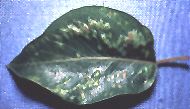
Pearleaf Blister Mite, Eriophyes pyri
(Pagenstecher)
I. Introduction: Pearleaf blister mite
(PLBM), also known as pear bud mite, and also by the synonym Phytoptus pyri Pagenstecher,
is
most often seen
in unsprayed trees. This species is part of a complex of related
species (E. pyri complex), which has
confused accounts of life history.
II. Hosts: This species of eriophyid mite is restricted to
pear.
Apple, quince, hawthorn,
serviceberry, cotoneaster, mountain ash and other related species
have
also been listed as hosts, but this
reflects the clouded nature of the species complex.
III. Description: The bodies of these eriophyids are
elongate
and wormlike. The body length is
1/100 inch (200-240 microns; 0.2 mm). Other details have been
published
separating it from other
eriophyids, but these will not be seen without a compound
microscope.
While in the bud, mites are white;
later in the season they assume a pinkish color.
IV. Biology: PLBM has two general types of life cycle; this
may
reflect different geographical
strains or species. In some areas (California, South Africa), a
bud
cycle exists which can cause up to
a 25% reduction of production. In eastern North America, with its
conditions of higher humidity, the
leaf blister cycle is much more common. These differences relate
to
summer aspects of the life cycle. In
both cycles, mites overwinter under buds. Only the blister form
will be
discussed further.
No reproduction or feeding occurs during winter in the buds. Mites
begin to feed and oviposit as buds
swell in the spring. Blisters begin to form at the cluster bud
stage,
on leaves 1/20 - 1/5 inch (1-5 mm)
long. After 1-2 weeks, blisters begin to form small holes. Mites
enter
these holes and begin egg
production. Usually only one female enters each blister. If
present in
fruit buds, feeding on floral
parts will cause fruit blisters. Females produce 7-21 eggs each.
In
cooler weather, about 18 days are
required for development; only 5-8 days are required in warmer
weather.
There are 2-3 generations per
year. Activity ceases during June, July and August, resuming when
cool
evenings return. Mites return
to buds from September to November.
V. Injury: This complex causes blisters on the undersides
of
pear and apple leaves, especially
younger foliage, usually in a row along the midvein (Plate 93).
The
blisters are tiny green swellings
at first, later expanding and turning red. These blisters
eventually
turn necrotic and brown (blisters
that are not invaded by mites remain green). The leaf epidermis is
loose and wrinkled on the underside
of the leaf, resembling a blister. The blisters may coalesce,
forming
larger blistered areas along the
midvein. The leaf blade may turn yellow, leaving a dark band along
the
midvein, dark green on the top
and brown on the bottom of the leaf. Small blisters may also occur
on
stems and around the fruit
calyx. This may cause fruit drop, but this is usually less common
than
the foliar injury. Leaf injury
can result in small, sparse leaves.
VI. Monitoring: Watch for blistering from PLBM on leaves
from
cluster bud through late season. No thresholds are currently
available from PLBM. If a
damaging population were detected,
control would be achieved in the next dormant spray.
VII. Management: Superior oil
during the dormant or delayed
dormant period. AgriMek plus oil before leaves harden. Lime
sulfur may also be applied in the postharvest
period.
Additional
sources:
University
of
California, Penn
State
University, British
Columbia, Cornell
University.
Back to Pear
page
Back to Mid-Atlantic
Regional
Fruit Loop
